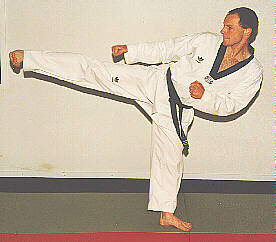![[General Taekwondo Information]](pics/gti.jpeg)
Belt requirements and origin

The color of the belt is an indication of the skill level of a Taekwondo student. Sometimes belts can be gained by winning competitions, the common way is by completing an exam.
A brief history of Geup/kyu/dan (kyu is the Japanese equivalent of Geup) ranking systems and belts, contributed by Steve Gombosi follows:
Before Jigoro Kano invented Judo, there was no kyu/dan ranking system. Kano invented it when he awarded "shodan" to two of his senior students (Saito and Tomita) in 1883. Even then, there was no external differentiation between yudansha (dan ranks) and mudansha (those who hadn't yet attained dan ranking). Kano apparently began the custom of having his yudansha wear black obis in 1886. These obis weren't the belts karateka and judoka wear today - Kano hadn't invented the judogi (uniform) yet, and his students were still practicing in kimono. They were the wide obi still worn with formal kimono. In 1907, Kano introduced the modern gi and its modern obi, but he still only used white and black.
Karateka in Okinawa didn't use any sort of special uniform at all in the old days. The kyu/dan ranking system, and the modern karategi (modified judogi) were first adopted by Funakoshi in an effort to encourage karate's acceptance by the Japanese. He awarded the first "shodan" ranks given in karate to Tokuda, Otsuka, Akiba, Shimizu, Hirose, Gima, and Kasuya on April 10, 1924. The adoption of the kyu/dan system and the adoption of a standard uniform based on the judogi were 2 of the 4 conditions which the Dai-Nippon Butokukai required before recognizing karate as a "real" martial art. If you look at photographs of Okinawan karateka training in the early part of this century, you'll see that they were training in their everyday clothes, or (!) in their underwear.
Most other arts that have ranking/belt color systems adopted them from the Japanese.
The explanation of belt colors was derived from the book of General Choi Hong Hi.
The requirements below are not official, but just an indication of how an exam can be taken. We use this as a guideline for our exams. The Korean language is slowly learned, because you have to know all the terms used in the Poomse's and techniques you show.
In WTF Taekwondo there are 10 Geups, starting from the 10th Geup (white belt) and ends with the 1st Geup (red-black belt). The term "Geup" means degree. The term "Dan" means phase. There are 9 Dan degrees, starting with the first and ending with the 9th. All Dan-degrees are represented by a black belt.
White Belt (10th Geup)
The color white indicates that a person is "innocent", has no knowledge of the sport Taekwondo. The white-belt is automatically gained by taking Taekwondo classes.
Yellow Belt (8th Geup)
The color yellow indicates that the person is getting to know the basic techniques, this stadium is compared to a plant growing its roots.
The student going for yellow-belt is usually not skilled enough to show "Chayu daeryon" (non-contact sparring). Instead the student has to show "Sajoe" ("four-direction-movement", one specific technique shown to all directions).
| Sam-bo Daeryon (three-step sparring) | number : 3 |
| Chayu Daeryon (non-contact sparring) | none |
| Ban-Chayu Daeryon (various techniques at a target) | one-and-a-half minute |
| Style form (Poomse Taeguk) | 1 |
| Kyepka (break test) | none |
| Hosinsul (self-defense) | 1 wrist, 1 throat |
Green Belt (6th Geup)
The color green indicates that a student is growing as a Taekwondo student. The color of the belt is compared to a plant growing its leafs.
| Il-bo Daeryon (one-step sparring) | number : 6 |
| I-bo Daeryon (two-step sparring) | number : 2 |
| Chayu Daeryon (non-contact sparring) | one-and-a-half minute |
| Ban-Chayu Daeryon (various techniques at a target) | one-and-a-half minute |
| Styleform (Poomse Taeguk) | 1-3 |
| Kyepka (breaktest) | none |
| Hosinsul (self-defense) | 3 wrist, 3 neck, 1 tobok |
Blue Belt (4th Geup)
The color blue indicates that a student is reaching higher, like a plant that is growing towards the sky.
| Il-bo Daeryon (one-step sparring) | number : 3 |
| Chayu Daeryon (non-contact sparring) or W.T.F.-sparring | one-and-a-half-minute |
| Ban-Chayu Daeryon (various techniques at a target) | one-and-a-half minute |
| Styleform (Poomse Taeguk) | 1-5 |
| Kyepka (breaktest) | one |
| Hosinsul (self-defense) | 3 wrist, 4 neck, 2 tobok, 1 from behind |
Red Belt (2nd Geup)
The color red indicates danger. The student is warned to practice the control of his/her movements. The color red also warns an opponent.
| Il-bo Daeryon (one-step sparring) | number : 12 |
| Chayu Daeryon (non-contact sparring) or W.T.F.-sparring | one-and-a-half-minute |
| Ban-Chayu Daeryon (various techniques at a target) | one-and-a-half minute |
| Styleform (Poomse Taeguk) | 1-7 |
| Kyepka (breaktest) | two |
| Hosinsul (self-defense) | 4 wrist, 4 neck, 4 tobok, 3 from behind |
Poom
W.T.F. Taekwondo requires that one has to be 16 years old to get a black belt. If younger, you get a Poom, which can be replaced by a black-belt when passed the age of 16. The requirements are the same as for the black-belt.
Black Belt (1st dan)
Black is the opposite of white and means the maturity of the student in the art. It also is an indication of being impenetrable for fear and darkness.
A black-belt has to know all the aformentioned. There is also a special pattern for black-belts. The patterns follow the Poomse Taeguks as well as the Poomse Palgwes.
- 1st Dan - Poomse Taeguk 1-8
- 2st Dan - Poomse Koryo
- 3rd Dan - Poomse Keumgang
- 4th Dan - Poomse TaeBaek
- 5th Dan - Poomse Pyongwon
- 6th Dan - Poomse Sipjin